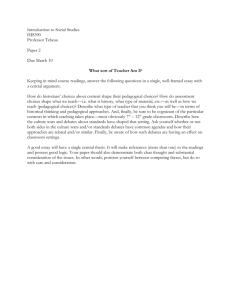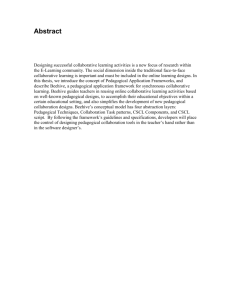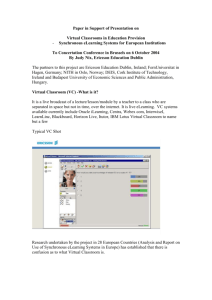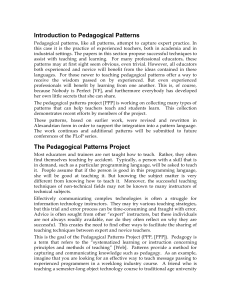- e-Lis
advertisement
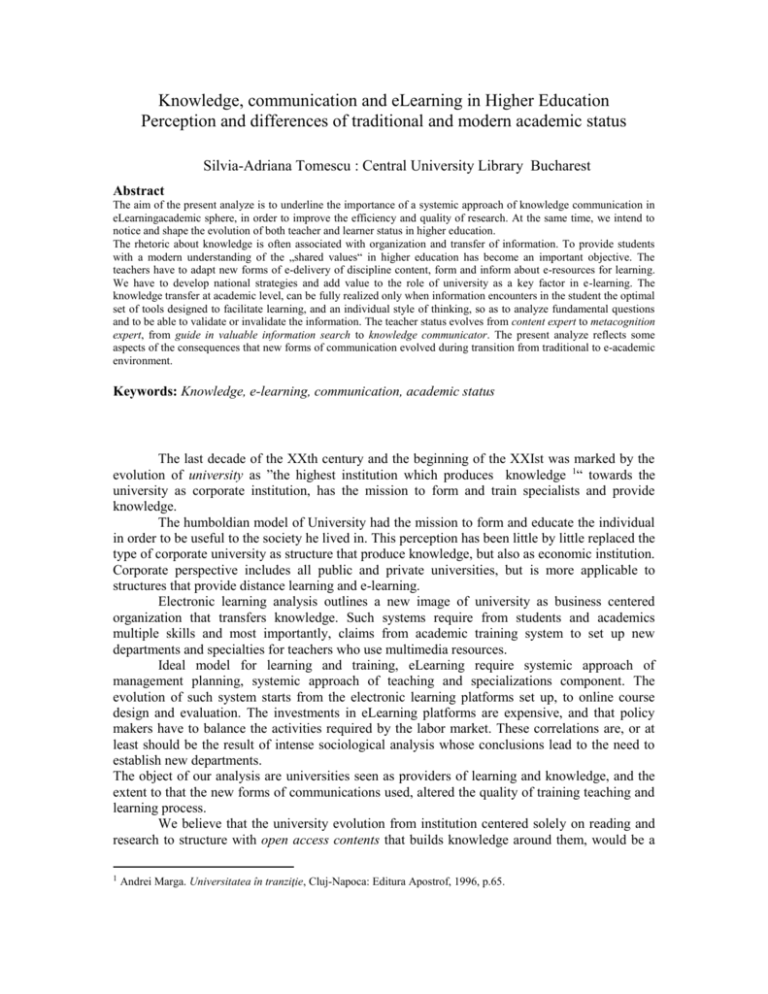
Knowledge, communication and eLearning in Higher Education Perception and differences of traditional and modern academic status Silvia-Adriana Tomescu : Central University Library Bucharest Abstract The aim of the present analyze is to underline the importance of a systemic approach of knowledge communication in eLearningacademic sphere, in order to improve the efficiency and quality of research. At the same time, we intend to notice and shape the evolution of both teacher and learner status in higher education. The rhetoric about knowledge is often associated with organization and transfer of information. To provide students with a modern understanding of the „shared values“ in higher education has become an important objective. The teachers have to adapt new forms of e-delivery of discipline content, form and inform about e-resources for learning. We have to develop national strategies and add value to the role of university as a key factor in e-learning. The knowledge transfer at academic level, can be fully realized only when information encounters in the student the optimal set of tools designed to facilitate learning, and an individual style of thinking, so as to analyze fundamental questions and to be able to validate or invalidate the information. The teacher status evolves from content expert to metacognition expert, from guide in valuable information search to knowledge communicator. The present analyze reflects some aspects of the consequences that new forms of communication evolved during transition from traditional to e-academic environment. Keywords: Knowledge, e-learning, communication, academic status The last decade of the XXth century and the beginning of the XXIst was marked by the evolution of university as ”the highest institution which produces knowledge 1“ towards the university as corporate institution, has the mission to form and train specialists and provide knowledge. The humboldian model of University had the mission to form and educate the individual in order to be useful to the society he lived in. This perception has been little by little replaced the type of corporate university as structure that produce knowledge, but also as economic institution. Corporate perspective includes all public and private universities, but is more applicable to structures that provide distance learning and e-learning. Electronic learning analysis outlines a new image of university as business centered organization that transfers knowledge. Such systems require from students and academics multiple skills and most importantly, claims from academic training system to set up new departments and specialties for teachers who use multimedia resources. Ideal model for learning and training, eLearning require systemic approach of management planning, systemic approach of teaching and specializations component. The evolution of such system starts from the electronic learning platforms set up, to online course design and evaluation. The investments in eLearning platforms are expensive, and that policy makers have to balance the activities required by the labor market. These correlations are, or at least should be the result of intense sociological analysis whose conclusions lead to the need to establish new departments. The object of our analysis are universities seen as providers of learning and knowledge, and the extent to that the new forms of communications used, altered the quality of training teaching and learning process. We believe that the university evolution from institution centered solely on reading and research to structure with open access contents that builds knowledge around them, would be a 1 Andrei Marga. Universitatea în tranziţie, Cluj-Napoca: Editura Apostrof, 1996, p.65. progress element of a modern educational system. The explosion of information, distribution channels, proliferation of information sources, claimed a consistently knowledge management. Knowledge organization and its communication in higher education is from this perspective, a scientific and technical process that: (a) shows how information is produced, (b) governs the procedure of information selection, allowing interconnection of data sets defined by logical criteria (c) creates interconnections between information storage and distribution arrangements, (d) attributes value to information and allow its use in research. Information influenced civilization and society’s architecture changing the value systems, and acting as a modernization factor. When we talk about knowledge in the area of higher education we take into account the framework components of the managerial process: the system which applies, the staff involved, the processes performed on an articulated strategy. The managerial knowledge dynamic in higher education space envisages several fundamental processes: knowledge acquisition, knowledge storage, knowledge creation, knowledge application in learning and research and finally but perhaps most relevant to its purpose, harnessing the knowledge, communication and knowledge transfer . In any academic structure, the performance of university education is given by research and by the quality of scientific work produced. The learning research in relation to knowledge is necessary not only to highlight the proportion of information that becomes knowledge, but especially to see the interrelation that these associations determined. Rhetoric about knowledge is often confused with information transfer processes which is embedded in the same concept. Organizing information is the first step in scientific research; an accumulation of information can be characterized by semantic value they carry, but cannot be called knowledge. In this review, we talk about knowledge as mental process, about transmission, understanding and teaching learning and communication styles. At individual level, knowledge builds on the structure of information already learned, starts from it and use critically, turning into other types of knowledge. Modern approaches of communication in the eLearning university envisage, in addition to traditional transmission and reception of messages2, the behavior of the actors involved in communication, understanding and exchange of coded communication, the specificity of relations established between interlocutors, student-teachers-tutors, diverse channels of communication, and modern means of electronic communication: email, chat, television, video conferencing. Palo Alto School of Communication characterize communication as a continuous, circular process a cyclical interaction between the actors involved produced through a variety of means; starting from the organic design of communication, they concluded: everything is communication! ... Communication including: science dynamics, daily experiences and life in all aspects. Palo Alto School representatives found that the communication process is like an orchestra, and each actor involved in communication was like a musician. The elements of this model are systemic structured, working together to get the sense expected. Teaching offers the status of knowledge and information communicator, problem solving guide, aspect that is underlined by professor Tony Bates ”What is the e-teacher status comparing to the “old/traditional” one? Still poor, I 2 În Joint Cognitive Systems: Foundation of cognitive systems engineering, Taylor & Francis, 2005, David D Woods and Erik Hollnagel called Shanon –Weaver communication model “the mother of all the models”. Constantin Cucoş from Iaşi University notes that „the telegraphic perspective about the communication is replaced by the interactive model that envisage the communicative act as an exchange relation between double-status partners-transmitter and receptor; so the older role of teacher as transmitter and student as receptor becomes questionable” http://constantincucos.blogspot.com/2009/11/curriculum-ascuns-si-etos-relational-in.html guess, because without re-design, they have to spend more time teaching and hence less time on research (or family) Also there are no rewards (appointment, promotion, etc.) for doing elearning.“3 Emerges from professor Bates declaration that teachers need to spend more time researching; academic professor still is (forced by circumstances and constrained by tasks) focused on teaching and course design. If the traditional model of teaching content was offered, explained, and standard ideas given also, all defined with the same term: "knowledge", that was sought to be acquired, the teacher's role evolved from content expert, teaching instructor or metacognition expert, determining student to emphasize the critical thinking. Electronic learning environment contributes decisively to the shaping functions and powers of the teacher called in literature e-teacher, tutor, guide, e-tutor. Authoritative role of traditional teacher will be gradually and completely replaced by that of guide, mentor, consultant. We agree with Peter Goodyear explanation of antithetical roles of tutor teaching in traditional and electronic environment: (a) the content provider-content designer, (b) reader-advisor, guide, (c) provider-queries pedagogical expert (d) single-teacher-teaching and learning team member. For the teacher working with students online, Gilly Salmon introduced in literature the concept emoderator: “the new generation of teachers and trainers who work with learners online”4 and proposes us a model of individual learning experiences across five stages (a) access and motivation, (b) online socialization, (c) information exchange, (d) knowledge construction (e) development.” If a teacher or instructional factor that operate and guide the development of students does not provide quality information, if the student's mind does not allow modeling of information and concepts submitted, then the development will always be one step back, and in extreme situations, students will be impossible to study in the electronic environment. Knowledge transfer can be fully realized only when information encountered inside students optimal set of tools designed to facilitate learning, especially an individual style of thinking, that allow submission of data to fundamental questions, conditions and situations and to help verify, validate or invalidate the information. Dave Knowlton emphasizes the role of collaborative learning in online environment that allows better learning of knowledge construction. "Knowledge construction is best accomplished through collaboration. In general, students learn through the give-and-take among classmates. That is, as students write contributions to discussions, they learn what it is that they are trying to say. The replies that they receive from their classmates further this learning "5. Shulman model focuses on pedagogical knowledge from the knowledge offered by educational content, defining this type of knowledge: "a mix between content and pedagogy that emphasizes how are structured, represented, and adapted subjects, issues, interests and abilities of student issues, and presented in order to train "6, he admits that such knowledge is the sum of knowledge content and knowledge of the of educational outcomes, and from their interrelation perspective he defined the pedagogical content knowledge (pedagogical content knowledge).7 American researchers Greta and Todd Kent Morin Dershimer say that there is a strong correlation between general pedagogical knowledge built on in-depth study, research and academic literature, and the personal pedagogical knowledge influenced by the personal analysis and synthesis, 3 http://www.elearningeuropa.info/directory/index.php?page=doc&doc_id=15527&doclng=6 Gilli Salmon. E –moderating : the key to the teaching and learning online. London: Rutledge, 2003 p. VIII 5 Dave Knowlton, H. Knowlton, C. Davis The whys and how's of online discussion. Syllabus: New Directions in Educational Technology, 13(10), 54-58. 6 L Shulman. Knowledge and teaching : foundation of a new reform. Harvard Educational Review, p. 8. Apud: PARK, Soonhye, OLIVER Steve, J. Revisiting the conceptualization of pedagogical content knowledge (PCK): PCK as a conceptual tool to understand teachers as professionals. În: Res Sci Educ, 38, p. 264. 7 Greta Morine – Dershimer; Todd Kent. The complex nature and sources of teachers’ pedagogical knowledge. În: J. Gess-Newsome and N. Lederman(Eds.) Examining Pedagogical Content Knowledge 21-50 Dordrecht, The Netherlands: Kluwer. 4 specific to the teachers. From Shulman model, they added conceptual categories and schematized pedagogical knowledge: Judgements Methods Outcomes evaluation Educational purposes, Values Pedagogic Knowledge Students Knowledge Learning priciples knowledge Curriculum Knowledge Pedagogic content knowledge Content knowledge Specific content knowledge General educational content knowledge Shulman believes that the scientific difference between a beginner teacher and an expert teacher is given just by knowledge; especially the latter's ability to convert knowledge into formulas to stimulate analytical thinking of students learning resources and content analysis. Pedagogical content knowledge8 is a fundamental skill that teachers must possess and develop mentioned by the American Association for Advanced Science and National Research Council. The theory, according to which discipline’s knowledge becomes after some important pedagogical processes content knowledge, is supported by Soonhye Park and J Oliver. 8 American Association for Advanced Science. Benchmarks for scientific literacy. Washington, DC: AAAS To support of this vision they proposed us a synthesis of this process definitions as it is reflected by the pedagogical literature: the transformation defined by Shulman, representation defined by Ball, DL, WR Veal and MaKinster J G called it translation., Bullogh VR, defined professionalization and J. Dewey and assumed the term psychologization. Conceptualization of content knowledge is the essential element that leads us to a better understanding of the role of academics in teaching and assessment. The authors propose us a heuristic analysis perspective of PCK (pedagogical content knowledge) - pedagogical content knowledge, set up a structured scheme of organizing the elements entitled: the hexadic model of pedagogical content knowledge (Fig. 2)9. The international literature emphasizes intensively the role of the constructivist approach of eLearning as way to construct and structure the knowledge, and less best teaching methods to accomplish such construction. We believe that in order to achieve a constructivist approach of learning, we have to apply a constructivist teaching. Although constructivism is specific to philosophy we have to articulate methods to apply it in eLearning teaching. One of the ways of knowledge building commonly used in eLearning is collaborative learning; forums, debates, 9 Ibidem, p.279. student blogs, e-portfolios, student-student dialogue and teacher-student are some of the best measures that allow the exchange of ideas and mental models, discover optimal correlations between theory and practice and mutual sharing of academic expertise. There are times when students are not enough motivated, or have not proper skills needed to apply the individual work methods communicated by the teachers although, presumably, they must arrive at college with a minimal set of skills: rapid reading and reasoning, critical thinking, logic articulated dialog, coherent argumentation. An essential tool for converting information into knowledge is didactic discourse, which through its function transmits the scientific information; it is an articulated discourse, structured on dedicated verbs: understand, explain, learn, demonstrate, assess, analyze, set up on a discipline, a subject, allowing interdisciplinary connections and creating new ideas and topics of scientific analysis. The final outcomes of teaching discourse cannot be other than information transmission, methods and ways of operating them in a manner that generates knowledge and specific behaviors. We take into account an academic discourse based on at least two techniques: persuasion, argumentation, built on didactic tools: teaching curricula, academic programs, and literature. Regarding the importance of understanding speech and its effects on the receiver (in this case student), Daniela Rovenţa-Frumusani said: ”we can hope to understand the language if we do not understand the discourse“10. Didactic discourse as scientific speech is from this perspective a logical one, constructed and institutionalized, designed for academic area. In eLearning we are preoccupied with interactional perspective of discourse analysis in teacher-student relationship. The Canadian professor Tony Bates told us about the role of teaching discourse in electronic media: "„Again, this is important in most subjects, although it does reflect a particular view on education – that learning is socially constructed – that not all professors share. Again, in an online environment, to ensure that discussion is focused and academic, rather than incoherent and shallow, the instructor/teacher has an important role to play, ensuring that the discussion stays on topic, that content/learning materials are drawn on to support the discussion, and the discussion operates at an academic level. "11 We agree Jacques Tardiff assertion, who discovered the tendency of students to memorize instead of being concerned to find a sense of taught content, who admitted that the new information and communication technologies are key elements to facilitate the circulation of knowledge and less its construction ”learning is the gradual building of knowledge ... by putting together (connecting) knowledge and new formation [...] the knowledge must be organized [...] it is accomplished by doing global tasks.“12. The degree of texts and contexts undestanting are guiding factors or, conversely, distraught the process of knowledge assimilation. Understanding is a core function of intelligence, that referrers to semantic content of a statement or a text, to the essence of a situation, to the essence of a problem, to a special the behavior, etc. Ioan Neacşu explains the scientific information evolution towards didactic information using the didactic transinformation13 concept, which needs information treatment on four lines: statistical, syntactic and semantic pragmatic. 1. Statistical coordinate apply to a body of information submitted to new concepts. 2. Semantic coordinate examines the dimension of submitted meaning - the amount and quality. 3. Pragmatic approach coordinates degree of utility of information and possible changes they will make to a fixed content established in advance by teacher. 4. Syntactic coordinate treats the way is structured information form and substance. Daniela Rovenţa-Frumuşani. Analiza discursului:ipoteze şi ipostaze. Bucureşti: Tritonic, p. 170. http://www.elearningeuropa.info/directory/index.php?page=doc&doc_id=15527&doclng=6 12 Jaques Tardif : Pour un enseignement stratégique l’apport de la psychologie cognitive Les Éditions Logiques Montréal, 1992, p. 72. 13 Ioan Neacşu. Instruire şi Învăţare. Bucureşti : Editura Ştiinţifică, 1990, p. 201. 10 11 When we understand, we make a clear idea about the nature of the problem, we represent it adequately " when there is correspondence between the meanings attributed to the source and the message given by the audience, there is understanding." 14 Understanding is influenced by the quality of message transmitted by the teacher, the arguments used and the extent to which they are found in the student's socio-cultural sphere. The ability to properly use the information demonstrates the knowledge of operating tools at maximum level of competence, dissemination, storage. Critical thinking applied to disseminated information guides the personal judgment of the student, of the teacher to appropriate teaching, learning and research. Jennifer Moon considers critical thinking as strategic thinking: ”ability to assess a range of information derived from multiple sources, to process this information in a creative and logical manner, challenging it, analyzing it and arriving at considered conclusions which can be defended and justified. Its opposites are prejudice and the risk to judgment. Knowledge has to be constructed –and its meanings change with the context.“15 Is the best tool to reveal the deep significations of things. Even more, is the judgment applied to a prior judgment in order to find alternative points of view, it is an individual ability to make interdisciplinary correlations. Critical thinking includes critical understanding, critical reflection, critical analysis, critical evaluation, essential elements in defining and manipulating knowledge. Information becomes knowledge when it is internalized, when provides understanding and can be explained, when can be argued, when operates with fundamental concepts, when proves its usefulness in practice and help in building other knowledge, contribute to understanding of the world. If the development of critical reading, documentation and synthesis are the traditional goals of higher education, in modern eLearning environment the need to focus and even explain these concepts becomes an urgent process. ”the process of information conversion into knowledge requires the addition of further relationship explanation, reinforcement, motivation elements, etc…and that because a theme or a subject developed in a field of science have not explicitly linked attitudes and formulas, are not accompanied by variations of presentation and no control information (feedback) they are usually actions that occur in teaching, namely the teaching and learning “ 16. Students' ability to deliver valuable judgments is one of the indicators that information has become knowledge. It is extremely important for distance students to be beneficial of a proper style, to provide a modern understanding of "sharing" values. Sothern England Consortium for Credit Accumulation and Transfer set critical thinking as level descriptor for master and doctoral studies. Becomes so clear that, more specialists in the design of eLearning styles need to adapt to these new (e)-forms, to provide knowledge and scientific information. Implemening eLearning in universities has created imbalance in time spent by teachers to prepare an online course. If reading was the scientific mainstream, and mainly informational support, now it becomes a mixed reading (print and electronic), writing and design courses are dependent on teacher's skills to use modern means of communication (from the computer, internet storage formats, export formats and online storage methods). Teachers will need more time for search, research, structure the information and teach. We are dealing therefore with innovation in the field of didactics and academic specialization but also a continued investment in enhancing the Francis, Balle. Comunicarea. În: Tratat de sociologie. Bucureşti : Editura Humanitas, 2006, p. 639 Jennifer Moon. Critical Thinking : an exploration of theory and practice. London: Rutledge, 2008, p. 21 16 Op.cit. p. 202 14 15 skills of working in an online environment that offers a lot, but require much more from such a system and its actors. If a university professor engaged in online teaching is aware of the responsibilities arising from his role, we must say that in Romania, we still have to clarify the role that online students have to be enroled in the same system. It’s true in this case that, as simple seems to be a student online, so much seriousness and academic and extra academic involvement entails. Off-campus environment should require students to access online scientific databases, digital content libraries, develop skills, working with university info-documentation system and dedicated language that such a level needs. In literature is often called knowledge era, but up there, we should stop at learning era as a definite challenge for the Romanian education system. Learning how to learn in a mix university system (from traditional to remote e-learning, blended learning, online learning) will be the objective of specialists in education design, and the success will depend on access to a knowledge era. BIBLIOGRAPHY 1. American Association for Advanced Science. Benchmarks for scientific literacy. Washington, DC: AAAS 2. Goodyear, Peter. (2000).Effective networked learning in higher education : notes and guidelines, Networked learning Higher Education (JISC CALT), 73. Available online: http://csalt.lancs.ac.uk/jisc 3. Grix, Jonathan.(2001). Demystifying postgraduate research. : from MA to PhD. Birmingham: University of Birmingham Press 4. http://www.elearningeuropa.info/directory/index.php?page=doc&doc_id=15527&doclng=6 5. Moon, Jenifer. (2008). Critical Thinking : an exploration of theory and practice. London: Rutledge. 6. Morine-Dershimer, Greta&Kent, Todd.(1999). The complex nature and sources of teachers’ pedagogical knowledge. In J. Gess-Newsome and N. Lederman(Eds.) Examining Pedagogical Content Knowledge 21-50 Dordrecht, The Netherlands: Kluwer. 7. National Research Council. National Science Education Standards. Washington, DC: National Academy Press. 8. Neacsu, Ioan.(1990). Instruire si invatare. Bucuresti: Editura Ştiinţifică. 9. Park, S., & Oliver, J. S. (2008). Revisiting the conceptualization of pedagogical content knowledge (PCK): PCK as a conceptual tool to understand teachers as professionals. Research in Science Education, 38(3), 261-284. 10. Shulman, Lee.(1987). Knowledge and teaching : foundation of the new reform. Harvard Educational Review, 15(2), 4-14



